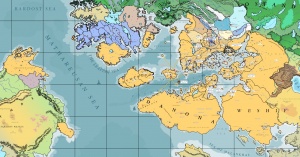Yophenthean Empire
History
The Yophenthean Empire was the
Asdarography and Demography
The Yophenthean Empire is largest of all human empires which history can vet. "It is not possible to study the Empire of the Yophentheans without great astonishment at its superlative greatness." Only the mythical empires of the titans and the gods were greater. At its greatest extent around 800 AI, the empire covered joined five continents and all the isles of the Pallathantic Sea under its rule. The Yophenthean Empire governed all of [[Danona], all of Pytharnia, the lands that are now Amerzcelindo, all of the lands that now comprise the Aurician Empire, all of Shelekhumbia and the western half of Weshif, including Shagrela'al, and the lands of southern Barathorn that now comprise Glaye. The Yophentheans called any land outside of their rule as the "Dawning Lands" and its intended use was chiefly for Thrace.
Languages
The official language of the Yophentheans was their own tongue, Classical Yophenthean, and they spread this tongue throughout their empire through conquest, religion, and theocratic bureaucracy. Colonization also brought the language greater permanency in the lands where Yophentheans emigrated and settled. However, the Yophentheans only insisted upon their language for the higher observances of their religion and official government business. Local languages, including Classical Ithatian, Midretassene, and Khahonri were permitted and in many cases studied by Yophenthean governors to better inform their administration.
Classical Arathracianism
Theocracy and Military
Economy
Architecture and Engineering
Arathracian Dome
The great, sprawling dome of the Arathracian Temple is the most well-known shape of Yophenthean Architecture and was employed in Temples and Basilicas.
Samagolean Wall
The Arts
Literacy and Education
Literature
Legacy
References
Sources
See Also
- List of the Rulers of the Golden Empire of Pytharnia
- List of Yophenthean Rulers of Erechóreb
- Yophenthean Successor States
| This article is a stub. It requires further development by the creator. |
